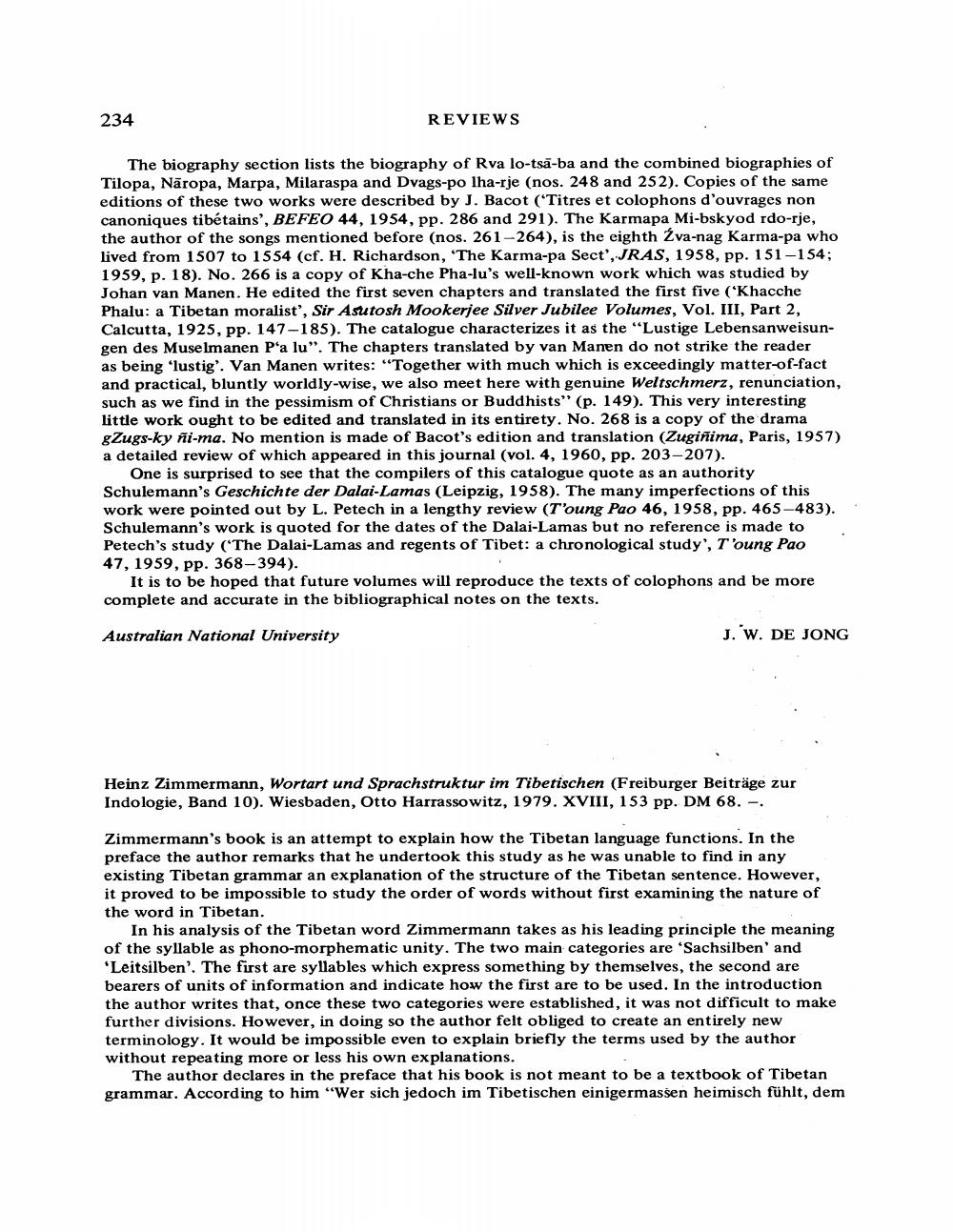________________
234
REVIEWS
The biography section lists the biography of Rva lo-tsa-ba and the combined biographies of Tilopa, Naropa, Marpa, Milaraspa and Dvags-po lha-rje (nos. 248 and 252). Copies of the same editions of these two works were described by J. Bacot ("Titres et colophons d'ouvrages non canoniques tibétains', BEFEO 44, 1954, pp. 286 and 291). The Karmapa Mi-bskyod rdo-rje, the author of the songs mentioned before (nos. 261-264), is the eighth Źva-nag Karma-pa who lived from 1507 to 1554 (cf. H. Richardson, "The Karma-pa Sect', JRAS, 1958, pp. 151-154; 1959, p. 18). No. 266 is a copy of Kha-che Pha-lu's well-known work which was studied by Johan van Manen. He edited the first seven chapters and translated the first five ('Khacche Phalu: a Tibetan moralist', Sir Asutosh Mookerjee Silver Jubilee Volumes, Vol. III, Part 2, Calcutta, 1925, pp. 147-185). The catalogue characterizes it as the "Lustige Lebensanweisungen des Muselmanen P'a lu". The chapters translated by van Manen do not strike the reader as being 'lustig'. Van Manen writes: "Together with much which is exceedingly matter-of-fact and practical, bluntly worldly-wise, we also meet here with genuine Weltschmerz, renunciation, such as we find in the pessimism of Christians or Buddhists" (p. 149). This very interesting little work ought to be edited and translated in its entirety. No. 268 is a copy of the drama gZugs-ky ñi-ma. No mention is made of Bacot's edition and translation (Zuginima, Paris, 1957) a detailed review of which appeared in this journal (vol. 4, 1960, pp. 203-207).
One is surprised to see that the compilers of this catalogue quote as an authority Schulemann's Geschichte der Dalai-Lamas (Leipzig, 1958). The many imperfections of this work were pointed out by L. Petech in a lengthy review (T'oung Pao 46, 1958, pp. 465-483). Schulemann's work is quoted for the dates of the Dalai-Lamas but no reference is made to Petech's study ('The Dalai-Lamas and regents of Tibet: a chronological study', T'oung Pao 47, 1959, pp. 368-394).
It is to be hoped that future volumes will reproduce the texts of colophons and be more complete and accurate in the bibliographical notes on the texts.
Australian National University
J. W. DE JONG
Heinz Zimmermann, Wortart und Sprachstruktur im Tibetischen (Freiburger Beiträge zur Indologie, Band 10). Wiesbaden, Otto Harrassowitz, 1979. XVIII, 153 pp. DM 68. -.
Zimmermann's book is an attempt to explain how the Tibetan language functions. In the preface the author remarks that he undertook this study as he was unable to find in any existing Tibetan grammar an explanation of the structure of the Tibetan sentence. However, it proved to be impossible to study the order of words without first examining the nature of the word in Tibetan.
In his analysis of the Tibetan word Zimmermann takes as his leading principle the meaning of the syllable as phono-morphematic unity. The two main categories are 'Sachsilben' and 'Leitsilben'. The first are syllables which express something by themselves, the second are bearers of units of information and indicate how the first are to be used. In the introduction the author writes that, once these two categories were established, it was not difficult to make further divisions. However, in doing so the author felt obliged to create an entirely new terminology. It would be impossible even to explain briefly the terms used by the author without repeating more or less his own explanations.
The author declares in the preface that his book is not meant to be a textbook of Tibetan grammar. According to him "Wer sich jedoch im Tibetischen einigermassen heimisch fühlt, dem




